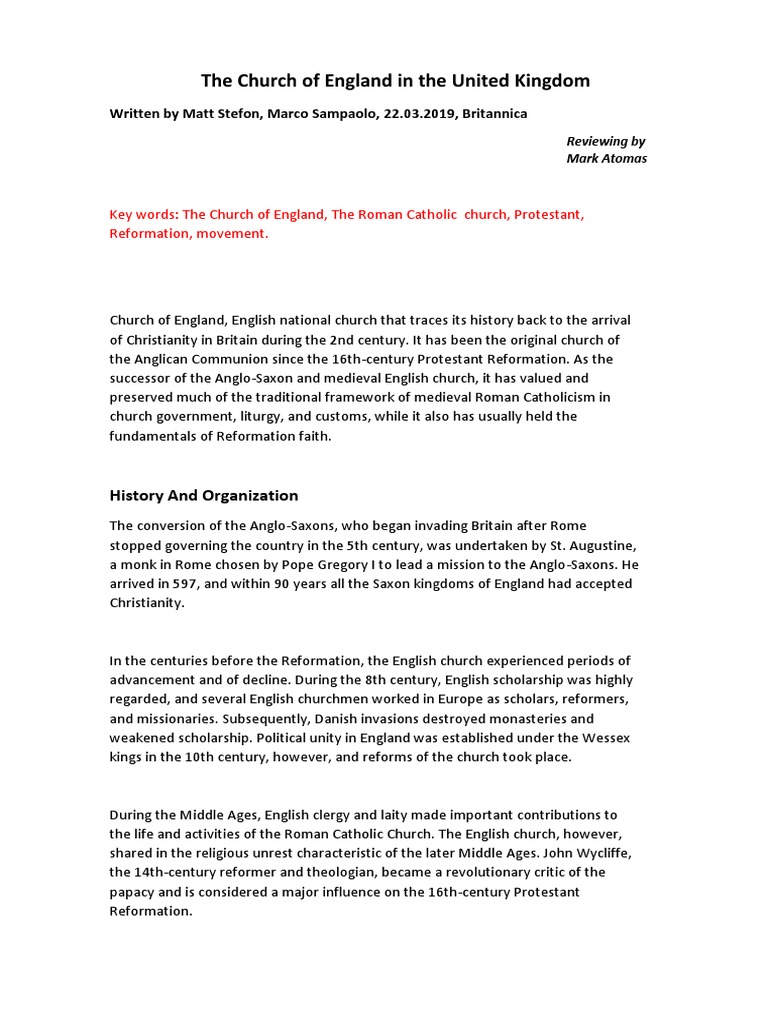The narrative surrounding the founding of the Church of England is a multifaceted tapestry woven from threads of politics, personal ambition, and profound theological convictions. Rooted in the broader context of the Reformation, the Church of England’s emergence is a story that encompasses royal decree, ecclesiastical strife, and a quest for spiritual authenticity. At its core, the question of who truly founded the Church of England transcends a mere historical inquiry—it invites us to explore the deeper implications of authority and belief.
To begin with, one must note the significant historical backdrop against which the Church of England emerged. The early 16th century witnessed a burgeoning wave of reformist fervor across Europe, as leaders such as Martin Luther challenged the hegemony of the Roman Catholic Church. In England, however, the factors driving the Reformation were not merely ideological; they were also intimately intertwined with the aspirations of Henry VIII. A charismatic monarch, Henry found himself in a predicament that ultimately catalyzed the formation of a new ecclesiastical body.
The crux of Henry’s dilemma revolved around his marriage to Catherine of Aragon, who had failed to provide him with a male heir. In an era when dynastic continuity was paramount, Henry’s anxieties gave birth to a longing for annulment—a request swiftly denied by Pope Clement VII. The pontiff’s refusal was not solely a matter of marital propriety; it was rooted in the complex political landscape of the time, wherein the Pope navigated allegiances with the Holy Roman Empire and various European monarchs.
Wielding power in both state and church, Henry perceived the Pope’s intransigence as an affront to his authority. Herein lies the pivotal moment that precipitated the English Reformation: Henry’s decision to sever ties with Rome. By establishing the Act of Supremacy in 1534, he proclaimed himself the Supreme Head of the Church of England, a bold and unprecedented declaration that would have enduring ramifications.
The establishment of the Church of England did not occur in isolation—it was accompanied by a series of reforms that redefined the relationship between the monarchy and its subjects. The dissolution of monasteries, for instance, was not merely an act of religious reform but also a strategy to augment royal wealth. The confiscation of monastic lands not only destabilized traditional structures of power within the church but also redistributed resources to a burgeoning class of loyalists, thereby consolidating Henry’s influence.
While Henry VIII is often heralded as the founder of the Church of England, it is essential to recognize that he was preceded by numerous reformist voices within England who laid the groundwork—most notably, figures such as John Wycliffe and Thomas Cranmer. Wycliffe, in the 14th century, advocated for the translation of the Bible into English, seeding the notion that scripture should be accessible to all people. Cranmer, who would later become the Archbishop of Canterbury, played a vital role in articulating the theological underpinnings of the new church, particularly through his contributions to the Book of Common Prayer, which sought to evoke both piety and a distinct English identity.
The intent behind the formation of the Church of England was not solely about governance; it echoed deep spiritual longings. Individuals across the social spectrum began to grapple with the implications of state-sponsored faith. For many, the new church offered a glimmer of hope—a chance to sever ties with what they perceived as a corrupt and autocratic Rome. The religious reforms initiated by Henry and his successors provided impetus for an evolving notion of faith and worship that would resonate with countless believers.
But this transition was fraught with tension. The theological landscape of the newly formed church was contentious and marked by competing interpretations of scripture and doctrine. The English Reformation birthed a diverse spectrum of beliefs, leading to the emergence of factions that would oscillate between Catholicism and Protestantism. Subsequently, the reigns of Mary I and Elizabeth I exemplified the turbulent interplay between religion and politics, as each monarch endeavored to impose their own theological vision upon a populace that was still grappling with the ramifications of profound change.
The Church of England’s establishment must be seen not simply as an act of royal power but as a reflection of a broader quest for identity and coherence in faith. While Henry VIII may have donned the mantle of the founder, the myriad voices that contributed to the Reformation encouraged a distinctively English expression of Christianity. In this context, one could argue that the Church of England is not a monolithic entity but rather a dynamic institution shaped by centuries of historical nuance.
Today, the legacy of the Church of England stands as a testament to the complexities of faith and governance. Its creation forces us to ponder the delicate balance of power and spirituality. It raises questions about the localization of faith within cultural contexts and the impact such institutional shifts have on collective identity. As we reflect upon this history, we find ourselves prompted to reconsider the sources of our beliefs and the structures that inform them.
Thus, the story of the Church of England’s founding is not only a historical account; it is a mirror reflecting contemporary struggles with faith, authority, and authenticity. This narrative compels us to delve deeper into our own practices and beliefs, challenging us to envision a faith that is rooted in personal conviction while engaging critically with the legacies of our past. In doing so, we may ultimately find a path towards a more profound understanding of our shared spiritual heritage.



